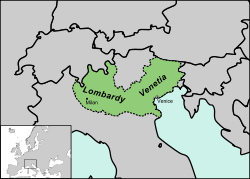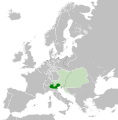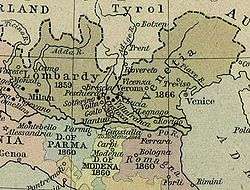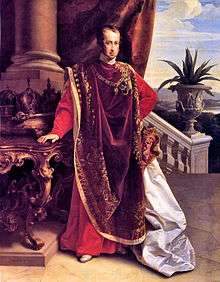Kingdom of Lombardy–Venetia
| Kingdom of Lombardy–Venetia | ||||||||||
| Regno Lombardo–Veneto (it) Königreich Lombardo–Venetien (de) Österreichisches Italien ("Austrian Italy")[1] | ||||||||||
| Crown land of the Austrian Empire | ||||||||||
| ||||||||||
| ||||||||||
 Outline of the Kingdom in 1852, superimposed on modern borders. | ||||||||||
| Capital | Milan and Venice (1815–1859) Venice (1859–1866) | |||||||||
| Languages | Italian, German | |||||||||
| Religion | Roman Catholic | |||||||||
| Government | Absolute monarchy | |||||||||
| King | ||||||||||
| • | 1815–1835 | Francis I | ||||||||
| • | 1835–1848 | Ferdinand I | ||||||||
| • | 1848–1866 | Francis Joseph I | ||||||||
| Viceroy | ||||||||||
| • | 1815 | Heinrich XV of Reuss-Plauen | ||||||||
| • | 1815–1816 | Heinrich von Bellegarde | ||||||||
| • | 1816–1818 | Anton Victor of Austria | ||||||||
| • | 1818–1848 | Rainer Joseph of Austria | ||||||||
| • | 1848–1857 | Joseph Radetzky von Radetz | ||||||||
| • | 1857–1859 | Maximilian of Mexico | ||||||||
| History | ||||||||||
| • | Congress of Vienna | 9 June 1815 | ||||||||
| • | Five Days of Milan | 22 March 1848 | ||||||||
| • | Lombardy ceded to France | 10 November 1859 | ||||||||
| • | Austro-Prussian War | 14 June 1866 | ||||||||
| • | Peace of Prague | 23 August 1866 | ||||||||
| • | Treaty of Vienna | 12 October 1866 | ||||||||
| Area | ||||||||||
| • | 1852 [2] | 46,782 km² (18,063 sq mi) | ||||||||
| Population | ||||||||||
| • | 1852 est.[2] | 4,671,000 | ||||||||
| Density | 99.8 /km² (258.6 /sq mi) | |||||||||
| Currency | Lombardy-Venetia pound, (1816–1860) Lombardy-Venetia florin (1860–1866) | |||||||||
| ||||||||||
| Today part of | | |||||||||
The Kingdom of Lombardy–Venetia (Italian: Regno Lombardo-Veneto, German: Königreich Lombardo–Venetien; Latin: Regnum Langobardiae et Venetiae), commonly called the Lombardo-Venetian Kingdom, was a constituent land (crown land) of the Austrian Empire. It was created in 1815 by resolution of the Congress of Vienna in recognition of the Austrian House of Habsburg-Lorraine's rights to Lombardy and the former Republic of Venice after the Napoleonic Kingdom of Italy, proclaimed in 1805, had collapsed.[3] It was finally dissolved in 1866 when its remaining territory fell to the Kingdom of Italy.
History
In 1814, Treaty of Paris the Austrians had confirmed their claims to the territories of the former Lombard Duchy of Milan, which had been ruled by the Habsburg Monarchy since 1718 and together with the adjacent Duchy of Mantua by the Austrian branch of the dynasty from 1713 to 1796, and of the former Republic of Venice, which had been under Austrian rule intermittently upon the 1797 Treaty of Campo Formio.
The Congress of Vienna combined these lands into a single kingdom, ruled in personal union by the Habsburg Emperor of Austria; as distinct of the neighbouring Grand Duchy of Tuscany, the Duchy of Modena and Reggio as well as the Duchy of Parma, which remained independent entities under Habsburg rule. The Austrian emperor was represented day-to-day by viceroys appointed by the Imperial Court in Vienna and resident in Milan and Venice.[2][4][5][6]
The Kingdom of Lombardy–Venetia was first ruled by Emperor Francis I from 1815 to his death in 1835. His son Ferdinand I ruled from 1835 to 1848. In Milan on 6 September 1838 he became the last king to be crowned with the Iron Crown of Lombardy. The crown was subsequently brought to Vienna after the loss of Lombardy in 1859, but was restored to Italy after the loss of Venetia in 1866.
Though the local administration was Italian in language and staff, the Austrian authorities had to cope with the Italian unification (Risorgimento) movement. After a popular revolution on 22 March 1848, known as the "Five Days of Milan", the Austrians fled from Milan, which became the capital city of a Governo Provvisorio della Lombardia (Lombardy Provisional Government). The next day, Venice also rose against the Austrian rule, forming the Governo Provvisorio di Venezia (Venice Provisional Government). The Austrian forces under Field Marshal Joseph Radetzky, after defeating the Sardinian troops at the Battle of Custoza (24–25 July 1848), entered Milan (6 August) and Venice (24 August 1849), and once again restored Austrian rule.
Emperor Franz Joseph I of Austria ruled over the Kingdom for the rest of its existence. The office of Viceroy was abolished and replaced by a Governor-General. The office was initially assumed by Field Marshal Radetzky, upon his retirement in 1857 it passed it to Franz Joseph's younger brother Maximilian (who later became Emperor of Mexico), who served as Governor-General in Milan from 1857 to 1859.
 Lombardy–Venetia (1853) and its major cities
Lombardy–Venetia (1853) and its major cities Lombardy–Venetia (1815) within the Austrian Empire
Lombardy–Venetia (1815) within the Austrian Empire Political map of Lombardy and Venetia
Political map of Lombardy and Venetia
End of the Kingdom
After the Second Italian War of Independence and the defeat in the Battle of Solferino in 1859, Austria by the Treaty of Zurich had to cede Lombardy up to the Mincio River, except for the fortresses of Mantua and Peschiera, to the French Emperor Napoleon III, who immediately passed it to the Kingdom of Sardinia and the embryonic Italian state. Maximilian retired to Miramare Castle near Trieste, while the capital was relocated to Venice, however, remaining Venetia and Mantua likewise fell to the Kingdom of Italy in the aftermath of the Austro-Prussian War, by the 1866 Peace of Prague.[7] The territory of Venetia and Mantua was formally transferred from Austria to France, and then handed over to Italy on 19 October 1866, for diplomatic reasons; a plebiscite marked the Italian annexation on 21–22 October 1866.[8]
Administration
Administratively the Kingdom of Lombardy–Venetia comprised two independent governments (Gubernien) in its two parts, which officially were declared separate crown lands in 1851. Each part was further subdivided in several provinces, roughly corresponding with the départements of the Napoleonic Kingdom of Italy.
Lombardy included the provinces of Milan, Como, Bergamo, Brescia, Pavia, Cremona, Mantova, Lodi-Crema, and Sondrio. Venetia included the provinces of Venice, Verona, Padova, Vicenza, Treviso, Rovigo, Belluno, and Udine.[7]
According to the Ethnographic map of Karl von Czoernig-Czernhausen, issued by the k.u.k. Administration of Statistics in 1855, the Kingdom of Lombardy–Venetia had a population of 5,024,117 people, consisting of the following ethnic groups: 4,625,746 Italians; 351,805 Friulians; 12,084 Germans (Cimbrians in Venetia); 26,676 Slovenians and 7,806 Jews.
 Provinces of Lombardy–Venetia
Provinces of Lombardy–Venetia Etnographic map of the Austrian Empire (1855) by Karl Freiherrn von Czoernig
Etnographic map of the Austrian Empire (1855) by Karl Freiherrn von Czoernig
Rulers
Kings
| Name |
Lifespan |
Reign start |
Reign end |
Notes |
Family |
Image |
|---|---|---|---|---|---|---|
| Francis I
|
12 February 1768 – 2 March 1835 (aged 67) | 9 June 1815 | 2 March 1835 | Habsburg-Lorraine |  |
|
Ferdinand I
|
19 April 1793 – 29 June 1875 (aged 82) | 2 March 1835 | 2 December 1848 (abdicated) |
Son of Francis I | Habsburg-Lorraine |  |
| Francis Joseph I
|
18 August 1830 – 21 November 1916 (aged 86) | 2 December 1848 | 12 October 1866 (deposed) |
Nephew of Ferdinand I | Habsburg-Lorraine |  |
Viceroys
- Heinrich XV, Prince of Reuss-Plauen 1814–1815
- Count Friedrich Heinrich von Bellegarde 1815–1816
- Archduke Anton Victor of Austria 1816–1818
- Archduke Rainer of Austria 1818–1848
- Count Joseph Radetzky von Radetz 1848–1857
- Archduke Maximilian of Austria 1857–1859
- Ferencz Gyulai 1859
Governors of Lombardy
- Heinrich Johann Bellegarde 1814–1816
- Francesco Saurau 1816–1818
- Giulio Strassoldo di Sotto 1818–1830
- Franz Hartig 1830–1840
- Robert von Salm-Reifferscheidt-Raitz 1840–1841
- Johann Baptist Spaur 1841–1848
- Maximilian Karl Lamoral O'Donnell 1848 (acting)
- Felix von Schwarzenberg 1848
- Franz Wimpffen 1848 (acting)
- Alberto Montecuccoli-Laderchi 1848–1849 (acting)
- Karl Borromäus Philipp zu Schwarzenberg 1849–1850 (acting)
- Michele Strassoldo-Grafenberg 1851–1857 (with the title of Lieutenant of Lombardy)
- Friedrich von Burger 1857–1859
Governors of Venetia
- Peter Goëss 1815–1819
- Ferdinand Ernst Maria von Bissingen-Nippenburg 1819–1820
- Carlo d'Inzaghi 1820–1826
- Johann Baptist Spaur 1826–1840
- Aloys Pállfy de Erdöd 1840–1848
- Ferdinand Zichy zu Zich von Vasonykeöy 1848 (acting)
- Laval Nugent von Westmeath 1848–1849 (military governor)
- Karl von Gorzowsky 1849
- Stanislaus Anton Puchner 1849–1850
- Georg Otto von Toggenburg-Sargans 1850–1855
- Kajetan von Bissingen-Nippenburg 1855–1860
- Georg Otto von Toggenburg-Sargans 1860–1866 (second time)
Sources
- ↑ Pütz, Wilhelm (1855). Leitfaden bei dem Unterricht in der vergleichenden Erdbeschreibung. Freiburg.
- 1 2 3 Fisher, Richard S. (1852). The Book of the World: Volume 2. New York.
- ↑ Rindler Schjerve, Rosita (2003). Diglossia and Power. Berlin.
- ↑ Francis Young & W.B.B. Stevens (1864). Garibaldi: His Life and Times. London.
- ↑ Pollock, Arthur William Alsager (1854). The United Service magazine: Vol.75. London.
- ↑ Förster, Ernst (1866). Handbuch für Reisende in Italien: Vol.1. Munich.
- 1 2 Rosita Rindler Schjerve (2003) "Diglossia and Power: Language Policies and Practice in the 19th Century Habsburg Empire", ISBN 3-11-017653-X, pp. 199-200
- ↑ 21st-22nd October 1866: annexation of Veneto to Italy (in Italian)
External links
-
 Media related to Kingdom of Lombardy-Venetia at Wikimedia Commons
Media related to Kingdom of Lombardy-Venetia at Wikimedia Commons - Flags of Lombardy–Venetia

